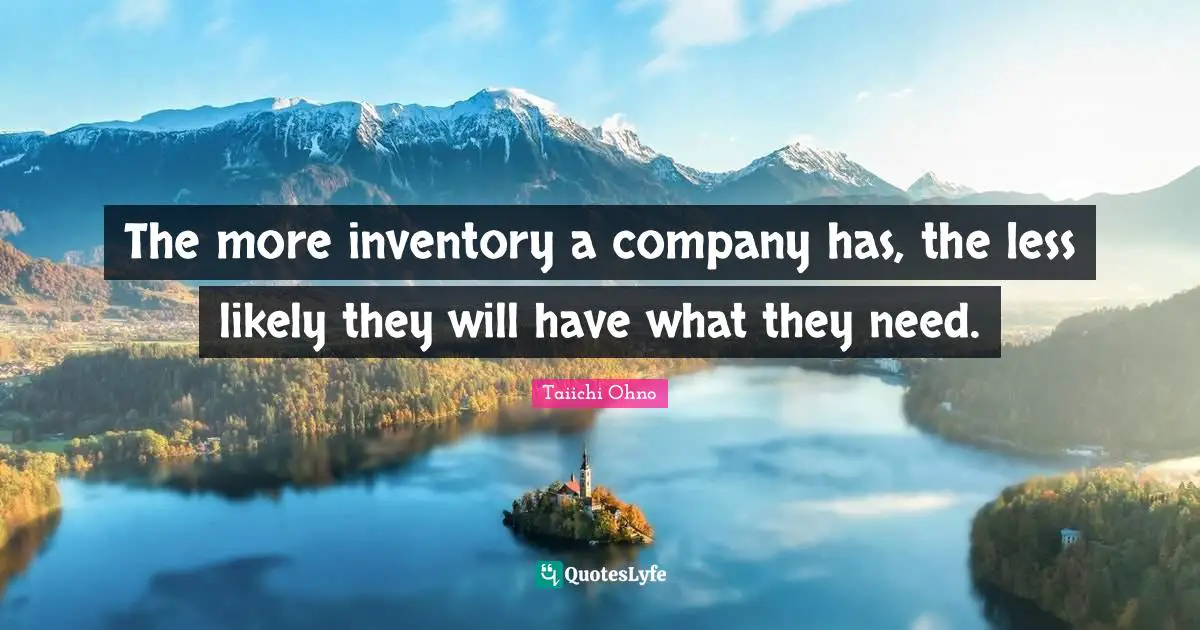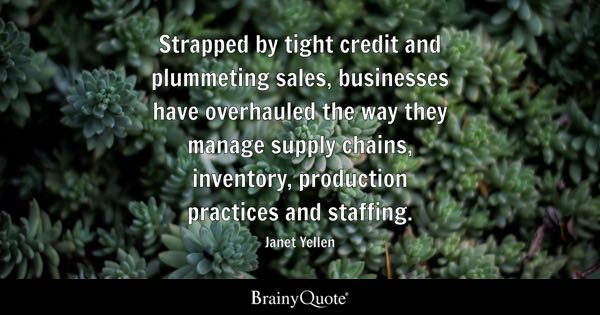
Unlocking the Wisdom: The Profound Impact of Business Inventory Quotes
Inventory – often perceived as merely goods on a shelf or raw materials in a warehouse – is, in reality, the pulsating heart of most businesses. It represents capital, potential, risk, and promise all at once. While the tangible aspects of inventory management are well-documented, there’s an often-overlooked dimension: the profound wisdom encapsulated in the "quotes" or foundational principles that guide its effective handling. These aren’t necessarily famous historical quotes, but rather the distilled insights, hard-learned lessons, and strategic imperatives that seasoned business leaders and supply chain experts live by.
This article delves into the profound wisdom embedded in these "inventory quotes," exploring how they illuminate the critical financial, operational, and strategic aspects of inventory management. By understanding and internalizing these principles, businesses can navigate the complexities of their supply chains, optimize their assets, and secure a sustainable competitive advantage.
1. "Inventory is Cash Sitting on a Shelf."
Perhaps the most fundamental and universally understood principle, this "quote" underscores inventory’s direct financial implications. Every item held in stock represents capital that could otherwise be invested, earning interest, or funding other critical business operations. When cash is tied up in inventory, it incurs a significant opportunity cost.
Elaboration: This principle extends beyond just the purchase price. It encompasses a myriad of "holding costs":
- Storage Costs: Rent, utilities, maintenance for warehouses.
- Insurance Costs: Protecting against loss, damage, or theft.
- Obsolescence Costs: The risk that inventory will become outdated, damaged, or unsellable before it can be moved. Think fashion items, electronics, or perishable goods.
- Spoilage/Shrinkage Costs: Actual physical loss due to damage, theft, or expiration.
- Financing Costs: The interest paid on loans used to purchase inventory.
Understanding this quote means recognizing that every unit of inventory is not just a product, but a financial asset with a shelf life, demanding careful stewardship. It compels businesses to critically evaluate their inventory levels, seeking to minimize excess stock to free up working capital and improve cash flow.
2. "Too Much Inventory is a Liability; Too Little is a Lost Opportunity."
This "quote" perfectly captures the delicate balancing act at the heart of inventory management. It highlights the dual risks associated with misjudging demand or supply.
Elaboration:
- Too Much Inventory (Liability): As discussed, excess stock ties up capital, increases holding costs, and heightens the risk of obsolescence. It can lead to markdowns, reduced profit margins, and even write-offs, directly impacting profitability. Furthermore, it can mask underlying operational inefficiencies, such as poor forecasting or unreliable suppliers.
- Too Little Inventory (Lost Opportunity): Conversely, insufficient stock leads to stockouts, which directly translate to lost sales and dissatisfied customers. In today’s competitive landscape, customers often have numerous alternatives, and a stockout can easily drive them to a competitor, potentially eroding long-term customer loyalty and brand reputation. It can also disrupt production schedules if raw materials are unavailable.
This principle emphasizes the need for sophisticated demand forecasting, robust supply chain relationships, and flexible operational strategies to find the "sweet spot" where inventory levels are optimized to meet demand without incurring excessive costs or risks.
3. "You Can’t Manage What You Don’t Measure."
A timeless business axiom, this "quote" is particularly pertinent to inventory management. Without accurate data and metrics, inventory decisions are based on guesswork, leading to inefficiencies and costly mistakes.
Elaboration: Effective inventory management relies on a constant stream of data, including:
- Sales Data: Historical sales trends, seasonality, promotional impacts.
- Demand Forecasts: Predictions of future customer demand.
- Lead Times: Time taken from placing an order to receiving inventory.
- Supplier Performance: Reliability, delivery accuracy, quality.
- Inventory Turnover Rate: How quickly inventory is sold and replaced. A higher turnover generally indicates efficient inventory management.
- Fill Rate: The percentage of customer orders that can be fulfilled immediately from stock.
- Stockout Rate: The frequency or percentage of times an item is out of stock.
Leveraging technologies like Enterprise Resource Planning (ERP) systems, Warehouse Management Systems (WMS), and advanced analytics tools allows businesses to collect, analyze, and interpret this data. This enables informed decisions about reorder points, safety stock levels, and procurement strategies, transforming inventory from a chaotic cost center into a strategically managed asset.
4. "The Goal of Inventory Management is Not to Eliminate Inventory, But to Optimize It."
While the desire to minimize inventory is strong, particularly given its associated costs, this "quote" provides a crucial caveat. Zero inventory is often an unrealistic and counterproductive goal.
Elaboration: Inventory serves vital functions:
- Buffering Against Uncertainty: It acts as a buffer against unpredictable fluctuations in demand or supply, protecting against stockouts and production delays.
- Economies of Scale: Purchasing in larger quantities can often lead to lower per-unit costs, offsetting some holding costs.
- Facilitating Production: Having raw materials on hand ensures a smooth production flow.
- Supporting Customer Service: Ready availability of products is key to meeting customer expectations for quick delivery.
Optimization means finding the ideal balance: enough inventory to meet anticipated demand and absorb reasonable fluctuations, but not so much that it becomes a financial burden. This involves techniques like Just-in-Time (JIT) where inventory arrives precisely when needed, but even JIT requires a highly reliable supply chain and predictable demand. For many businesses, a mix of strategies, including strategic safety stock, is necessary.
5. "Inventory is Ultimately About Serving the Customer."
This "quote" shifts the focus from internal financial and operational concerns to the external, customer-centric purpose of inventory. While cost efficiency is vital, the ultimate justification for holding inventory is to satisfy customer needs.
Elaboration:
- Product Availability: Customers expect products to be available when they want to buy them. Stockouts lead to frustration and lost sales.
- Speed of Delivery: In the age of e-commerce, rapid delivery is a key competitive differentiator. Well-positioned inventory allows for quicker fulfillment.
- Product Variety: Offering a wide range of products often requires holding diverse inventory.
- Reliability: Customers value businesses that can consistently meet their promises.
Viewing inventory through this lens helps businesses prioritize customer service metrics alongside cost metrics. It encourages investing in inventory that genuinely enhances the customer experience, even if it means carrying a slightly higher stock level for popular items or critical components.
6. "The Supply Chain is Only as Strong as Its Weakest Link – and Inventory is Often the Litmus Test."
This "quote" highlights inventory’s role as a diagnostic tool for the entire supply chain. Problems upstream (supplier issues, production delays) or downstream (poor sales, distribution bottlenecks) often manifest first in inventory imbalances.
Elaboration:
- Supplier Reliability: Inconsistent supplier performance can lead to unexpected stockouts or, conversely, a need for excessive safety stock.
- Production Inefficiencies: Bottlenecks in manufacturing can cause a buildup of work-in-progress inventory or delays in finished goods.
- Logistics Challenges: Inefficient transportation or warehousing can lead to delays in getting inventory to where it’s needed, or damage during transit.
- Sales and Marketing Misalignment: Overly optimistic sales forecasts or ineffective marketing campaigns can result in excess inventory.
By closely monitoring inventory levels, movement, and quality, businesses can identify and address underlying weaknesses in their supply chain. It prompts a holistic view, understanding that inventory problems are rarely isolated but often symptoms of broader systemic issues.
7. "In a Volatile World, Agility and Resilience are Your Best Inventory."
This more contemporary "quote" reflects the lessons learned from recent global disruptions (pandemics, geopolitical events, natural disasters). In an unpredictable environment, rigid inventory strategies can be catastrophic.
Elaboration:
- Agility: The ability to quickly adapt to changing market conditions, demand fluctuations, or supply disruptions. This might involve flexible manufacturing processes, multiple sourcing options, or responsive distribution networks.
- Resilience: The capacity to withstand and recover from shocks. This could mean maintaining strategic safety stock for critical items, diversifying supplier bases geographically, or having contingency plans for transportation.
- Visibility: Knowing exactly where your inventory is at all times, from raw materials to finished goods in transit, is crucial for agile decision-making.
This principle encourages a shift from purely cost-driven inventory decisions to ones that prioritize risk mitigation and operational flexibility. While these strategies might sometimes incur higher costs, the cost of being unprepared for a major disruption can be far greater.
Conclusion: Embracing the Inventory Wisdom
The "quotes" about business inventory are far more than mere sayings; they are the distilled essence of decades of operational experience and strategic foresight. They underscore that inventory management is not a static task but a dynamic, multi-faceted discipline that profoundly impacts a company’s financial health, operational efficiency, customer satisfaction, and long-term viability.
From the foundational understanding that "inventory is cash sitting on a shelf" to the modern imperative that "agility and resilience are your best inventory," these principles provide a robust framework for decision-making. Businesses that internalize and apply this wisdom – by leveraging data, optimizing stock levels, prioritizing customer needs, and building resilient supply chains – are better equipped to navigate the complexities of the market, turn potential liabilities into strategic assets, and secure their success in an ever-evolving global economy. The true power of inventory lies not just in the goods themselves, but in the wisdom applied to their management.

